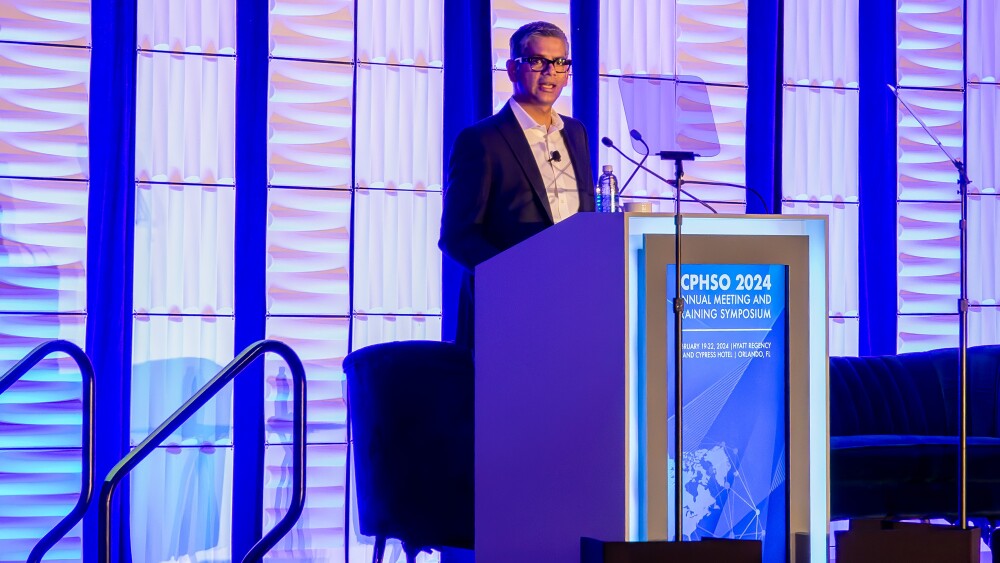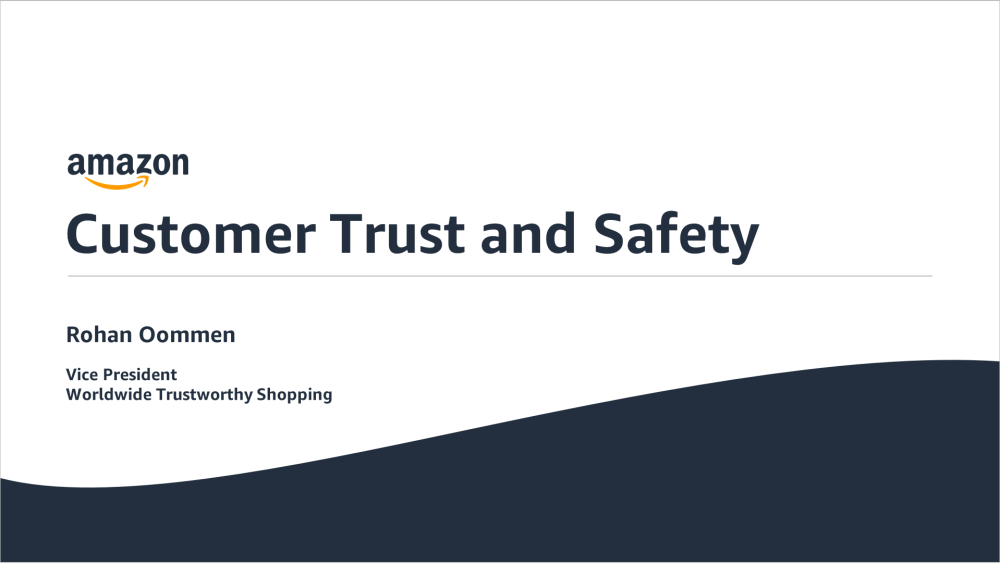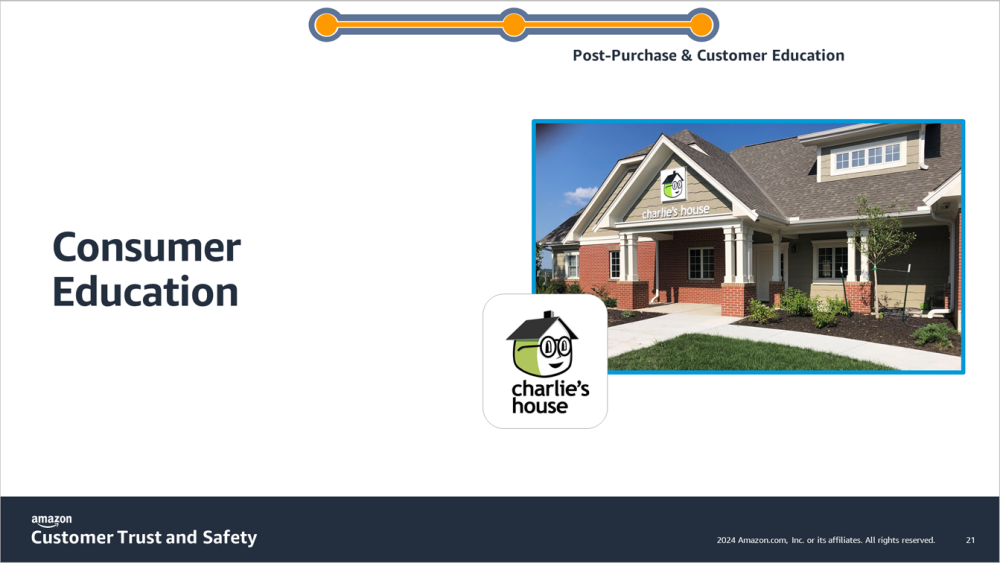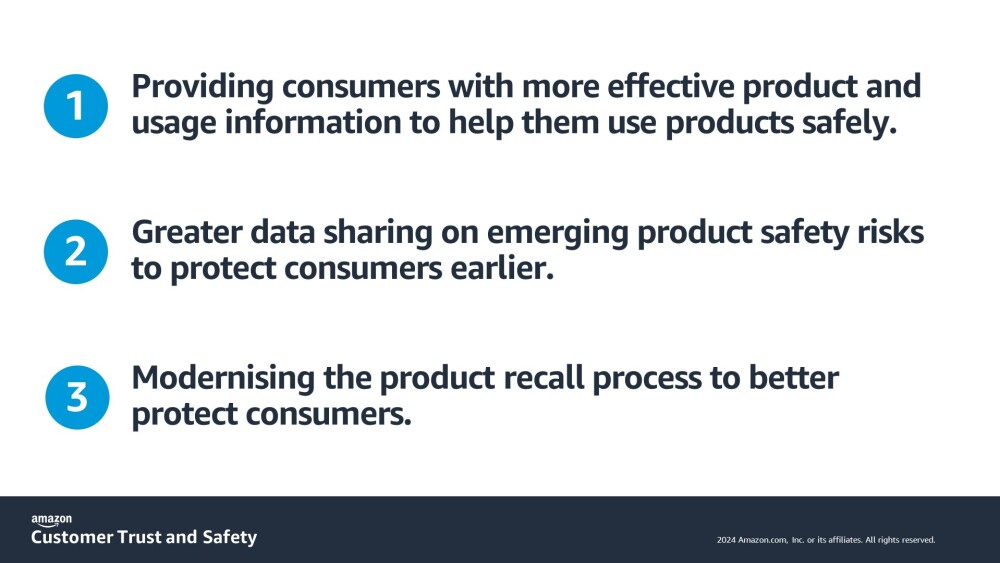Thank you to ICPHSO for welcoming me here today to the annual symposium. I am Rohan Oommen, Vice President of Worldwide Trustworthy Shopping at Amazon, and I am both excited and humbled to be here alongside so many industry leaders in product safety.
Amazon started as an online bookstore almost thirty years ago. Our mission was to become Earth’s most customer-centric company, where people can discover the widest selection of authentic and high quality goods. As part of that mission, we obsess over earning and maintaining the trust of our customers, ensuring we provide them with a trustworthy shopping experience.
In 2023, we invested more than 1.2 billion dollars and employed over 15,000 people – including machine learning scientists, software developers, and expert investigators – dedicated to protecting customers from: unsafe products, counterfeit, fraud and other forms of abuse.
Just a few years after we sold our first book, we expanded our product offerings to include music, films and electronics. We offer a lot more than that now and we move quite a bit faster than we did back then. In fact, in 2023, Amazon delivered products at our fastest speeds ever, with more than 7 billion units arriving on our customer’s doorsteps the same or next day after they placed the order.
As you can see in the video, we operate at scale and we know that level of scale brings with it a lot of responsibility. We are proud of our achievements but we also know we’re not perfect and can do better. We deeply care about our impact on the world and we think about the effects of our actions. Our local communities, planet and future generations need us to be better every day.
Toward that end, I’d like to use some of our time together, to show you how we apply this mentality to the journey a product goes through at Amazon, highlighting some of our progress over the last few years and the checks we’ve put in place to help keep unsafe products from ever reaching our customers.
We think of the product journey as having three parts.
Before a customer purchases anything, we have proactive controls that keep bad actors from selling in our store and unsafe products from being listed for sale.
Once a customer makes a purchase, the product begins its journey through our fulfilment process where it’s inspected for potential safety risks like damage and past expiry dates.
After the product is delivered, we listen to feedback from customers, communicate with them directly, and send them helpful content, like relevant safety tips or instructions on what to do if a product they bought from us has been recalled.
Let’s walk through the pre-purchase part of this journey, where our controls go into effect even before a customer sees a product in our store.
First, we verify the identity of all potential selling partners through a combination of advanced technology and expert human reviews. We do obvious verification checks that look at things like their address, business and tax information. But in addition, our systems analyse behavioural signals and numerous data points to understand if they are connected to networks of previously detected bad actors.
We use a combination of document forgery detection, advanced image and video verification and other technologies to quickly confirm the authenticity of government-issued identity documents and whether they match the individual applying to sell in our store.
Even after a seller is verified, we continue to monitor signals to detect if a seller’s identity has changed. If we feel the risk profile of a previously verified seller has heightened, we require them to go through our checks again in order to continue selling on Amazon.
Once sellers are verified and start listing products for sale, we have policies and processes in place to make sure what they’re listing, meets compliance and safety standards. This is another area where we apply advanced technology to protect customers. We leverage machine learning models to scan compliance documents to ensure that a product is safe and compliant before it goes live in our store.
In 2023, we scanned billions of attempted changes to product detail pages for signs of abuse. When necessary, we also augment our technology by flagging listings for deeper review by our team of safety and compliance experts.
When I talk about continuous monitoring, I’m also talking about things that go beyond just looking in our store and our inventory. We are always listening to feedback from customers, and other entities, to figure out if our proactive controls missed something along the way. To give you a sense of the scale of our listening mechanisms, every week we monitor roughly 70 million pieces of feedback, most of it in near real-time.
But we are always looking for ways to listen better and in 2023, we implemented a new feature which is a link on every product detail page that gives customers the ability to easily report a potential issue with a product or seller.
And if all this feedback indicates we missed something, we work hard to take care of it quickly.
For example, when we learned from our customers and partners about safety concerns tied to padded crib bumpers and inclined sleep products, we removed them from our store long before legislation passed. And then, we worked with partners like Kids in Danger, Consumer Federation of America, and Consumer Reports to advocate for the ‘Safe Sleep for Babies’ Act.
Similarly, based on concerns tied to water beads causing safety risks for children, we wrote a new policy that prohibits the listing or sale of water beads marketed to young children and removed them from our store.
A final piece of the pre-purchase journey is the information we give our customers before they’ve bought something. We frequently find that when a safety issue is reported to us, the underlying product was safe and had the right required consumer warnings, but the customer unintentionally used the product in a way that they should not have.
To address this, we’ve started to incorporate information like relevant safety articles and product tips directly within the shopping experience. These messages are built to be short and easy-to-understand. On the slide, you’ll see an example of a message we embedded onto our car-seat search pages in partnership with the National Highway Traffic Safety Administration as part of their ‘Right Seat’ campaign.
We are also partnering with a number of folks in this room – Safe Kids Worldwide, the Baby Products Manufacturers Association, and Charlie’s House – to provide safety and usage information for customers, right on our baby registry homepage – and we are expanding this to other countries this year. You can see some of the topics we cover, but there are many more like stroller safety and safe sleep. And while these topics rotate, consumers can access all of this information on our site at their convenience.
There is a lot of upside to be had by providing our customers safety information, when they need it most, and from trusted experts and I am optimistic about further improvements we can make.
Now I’m going to talk about what happens after a customer orders a product and it makes its way through our fulfilment network. I am proud of the innovations my team has built to keep customers safe though this process.
Our advanced technology is one of the reasons we’re able to move at the scale and speed that we do, and it does some pretty incredible things like detecting expired or damaged products, in a matter of seconds.
As you can see, in the video, our employees first pick the products from our inventory and visually inspect them for signs of damage before sending them on their way to the next stop.
One of the next safety checks is our imaging tunnels where product images are taken and analysed by a type of machine learning technology called computer vision.
Our scientists have trained these computer vision models to look for signs of damage and/or past expiry dates.
If we detect that an expiry date has passed, the item and the entire batch of inventory with the same expiry date is removed from fulfilment.
Last year, we inspected 188 million images in these tunnels, and we are expanding further in the coming year.
But product defects aren’t always things we can see by looking at the product exterior.
This video, highlights our X-ray review, when we detect risk signals, we analyse the inner workings of the product.
These X-ray scans give us the ability to see how closely a product, say with electrical components or a watch, lines up with an authentic technical drawing. We can even look at how the packaging around a beauty product is constructed, to determine whether the product is counterfeit, and therefore, potentially unsafe.
If no past expiry dates, damage or other defects are discovered during the pre-purchase or fulfilment process, the product is packaged, labelled and delivered to our customer’s doorstep.
Now for the third part of the product journey, let’s take a look at how we think about safety after a parcel is delivered to the customer.
I’ll start by sharing some examples of how we use post-purchase communication to send timely safety information.
Through our local programme in Japan, Anshin-Mail, our teams send out messaging to customers with actionable safety alerts related to high-risk products. When, a powerful earthquake hit the Noto Peninsula in Ishikawa Prefecture earlier this year knowing that power generators and portable gas cookers are often incorrectly used during natural disasters, we quickly identified over 16,000 customers in the affected areas, who had purchased these products from us, and sent them an email with tips for safe usage and we did this in just two hours after the initial earthquake hit.
This is a recent example but the team in Japan has partnered with organisations like the National Institute of Technology and Evaluation, National Consumer Affairs Center and the Fire Department to send over 50 million safety alerts to customers last year.
A different example is our partnership in the US with consumer advocates, Safe Kids Worldwide and Charlie’s House, to reduce preventable injuries by sending safety messages on safe-sleep and furniture-anchoring, to targeted customers based on their purchase history.
We are now working with Safe Kids Worldwide and the American Academy of Pediatrics to include information in our baby registry welcome boxes to keep new parents informed and safe on products they care about. It’s a good example of our goal to provide customers with safety content when they need it most.
Informing customers in the event of a product recall is another important way we think about post-purchase communications. We leverage technology to keep us up to date when a product we carry in our store has been publicly recalled. And when we learn of a recall, we: inform customers who purchased the recalled product, remove the product from our store, notify the seller and cancel any orders that have not yet been removed from our inventory.
While we have always told our customers about a product recall or other safety issue once we’ve become aware of it, consumers have typically depended on third-party websites to learn what they should do next.
To save our customers that extra step, in 2023 we launched the ‘Your Recalls and Product Safety Alerts’ page. This page gathers recall and safety information for products they’ve purchased in our store all in one place and offers guidance on steps that customers should take.
Beyond us communicating with customers about safety tips and recalls, customers can also contact us directly for a refund if they are not happy with the timely delivery or condition of their product. We call this our A-to-z Guarantee and we stand behind every product sold in our store.
In 2021, we expanded the Guarantee, in the US, to include a streamlined process for resolving personal injury or property damage claims caused by a defective product, even if the product was from a third-party seller in our store. As far as I am aware, we are the first, and only retailer that offers this level of protection for customers.
I’ve talked about what checks and technology we have in place to help keep customers safe in the Amazon store, but I’d like to switch gears a bit and take a moment to recognise some of our partners who have helped us along our journey.
I see many of them here in this room and we’ve worked together on some great initiatives and made amazing progress toward our shared goals.
We’ve partnered with governments on building product safety pledges that outline some of our aspirations for modernisation, and set standards and practices that we think all retailers should adopt. In Australia, Canada, the EU and Japan, the pledges we’ve signed with other industry partners, raise the bar for the retail industry and provide opportunity for new collaborations.
Under the EU ‘Product Safety Pledge +' we are part of an exciting pilot project where designated consumer groups can report potentially non-compliant and unsafe products to us, to be investigated and removed if needed. This exchange of safety signals across retailers and safety experts has already started to result in valuable collaboration and faster resolution of the issues flagged.
Zooming in a bit on another partnership – our work with Charlie’s House is an exciting relationship we’re expanding this year. As many of you know, Charlie’s House is a safety demonstration home where parents and caregivers can come to learn about hidden hazards and how to childproof their homes to reduce the risk of in-home accidents.
In 2023, we started talking with Charlie’s House about working together to scale their in-person experience into a virtual one, which would then open this up and connect millions of consumers to this important safety information. We’re excited to announce that this year, we will launch these virtual homes in the US, the UK and Canada, and we look forward to expanding to other countries and languages, as well as working with other safety experts in the future.
Onto the final topic I wanted to share with you today as you may have heard, we published our new Product Safety Blueprint last week.
We published the blueprint to speak to where we see opportunities to scale product safety efforts across sectors, and we see it as a framework to help us all modernise and innovate on product safety initiatives.
We see three main areas that we can focus on together.
Manufacturers spend a lot of time and resources on compliance, including the design, testing and certifications of products. But our experience tells us that customers don’t always pay attention to these well-intentioned efforts, and they can find it confusing to read the stickers and manuals that come with these products – which then can lead to unintentional use of otherwise safe products.
We need to do better to encourage customers to engage with safety instructions and keep themselves safe.
Manufacturers should be able to communicate easier-to-follow guidance that is not buried in multiple manuals and labels. We believe, a big way to improve this, is for manufacturers to provide this information digitally. This will help the information stay up to date, complete and in the customer’s preferred language. We are starting to see some regulators thinking about this more urgently, like the European Commission’s efforts to encourage digital labelling.
Retailers can and should then use this digital information and work with experts on how best to integrate safety information into the shopping journey, in the places its most valuable for consumers.
Another area that is vital to reducing safety incidents is greater information sharing across the industry. Today, we don’t have an easy way to share information on emerging safety risks between retailers, manufacturers and regulators. Depending on the country, it can take anywhere from weeks to several months, from the time a manufacturer notifies a regulator of an issue, to when that is communicated to retailers through a product recall.
We believe an industry-wide ‘information exchange’ must be established to help communicate emerging safety risks faster. We can all contribute information and leverage what is shared in the exchange to address emerging product safety risks.
Of course, this information exchange wouldn’t replace the need for formal legislation and standards, but it would be a huge enabler in allowing the industry to act quickly to protect consumers.
In the unfortunate situation where a product needs to be recalled across the industry, the current regulatory requirements are not effective enough.
The first challenge is getting sufficient information to identify and remove recalled products. In many cases, the information retailers receive is unclear, incomplete (missing key details like brand name, model, serial numbers) or late, making it difficult to identify and remove recalled products.
Second, once the product is identified, the methods of notifying customers are antiquated. Posters behind customer service counters and placing announcements in the news continue to be used as primary methods of communication. These methods are ineffective, as evidenced by data from the CPSC that showed that, in the US, on average, consumers participate in corrective actions for recalls only 6 percent of the time across all product types which means a large number of customers remain at continued risk.
At Amazon, we have simplified how our customers receive recall information – they receive immediate, actionable, and personalised emails as soon as a potentially unsafe product is identified. Notifications include information about potential safety hazards, detailed instructions on how to request a refund or if one has already been provided and instructions for how to return or dispose of the product.
We must establish more robust standards for basic product information that should always be included in every product recall, to enable fast identification of recalled products. And, whether products are purchased in a physical store or online, we should require retailers to contact customers directly – through online accounts, membership programmes, phone numbers or other means they have.
In closing, at Amazon we believe leaders create more value than they consume and always leave things better than how they found them. We must end every day knowing we can do even more tomorrow to protect consumers around the world. We are proud of the trust that customers have when shopping in our store and we will continue to innovate on behalf of our customers to prevent unsafe products from ever reaching them.
However, greater progress will require the private and public sector to work together to: provide consumers with more effective information, share information to prevent safety concerns sooner and modernise the product recall process so that recalled products are effectively removed from the supply chain.
We appreciate all of the wonderful partnerships we have currently that already have improved safety for consumers across the world and we look forward to innovating on behalf of customers and working together with you all in pursuit of this goal.


























